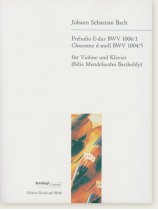Bach Preludio E-dur BWV 1006/1 Chaconne d-moll BWV 1004/5 für Violine und Klavier (Felix Mendelssohn Bartholdy)
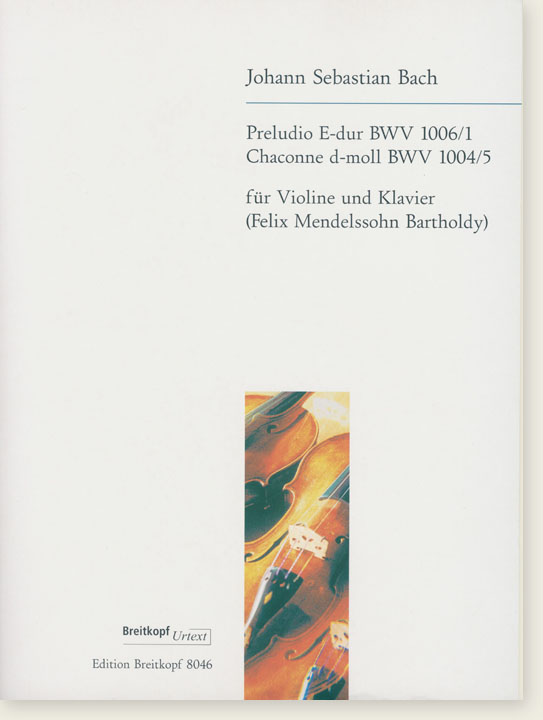
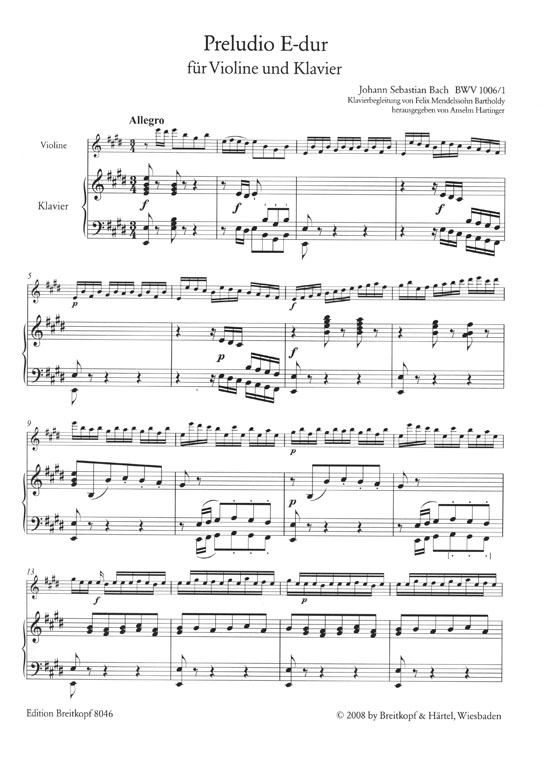
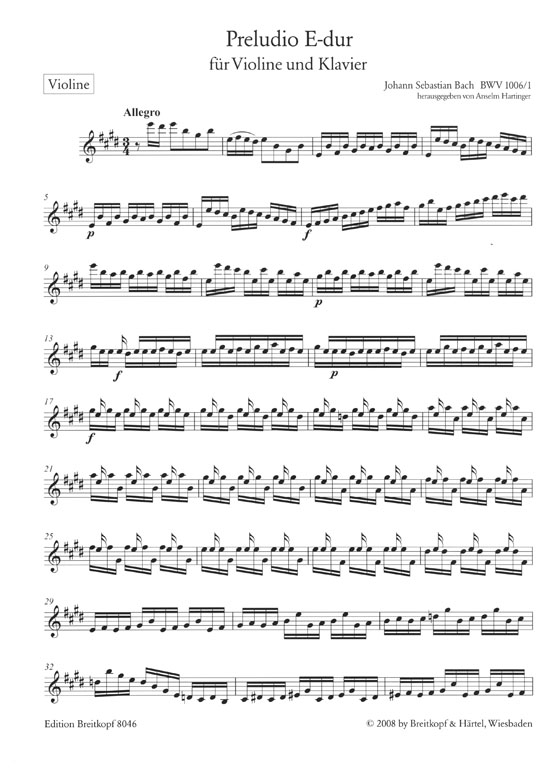
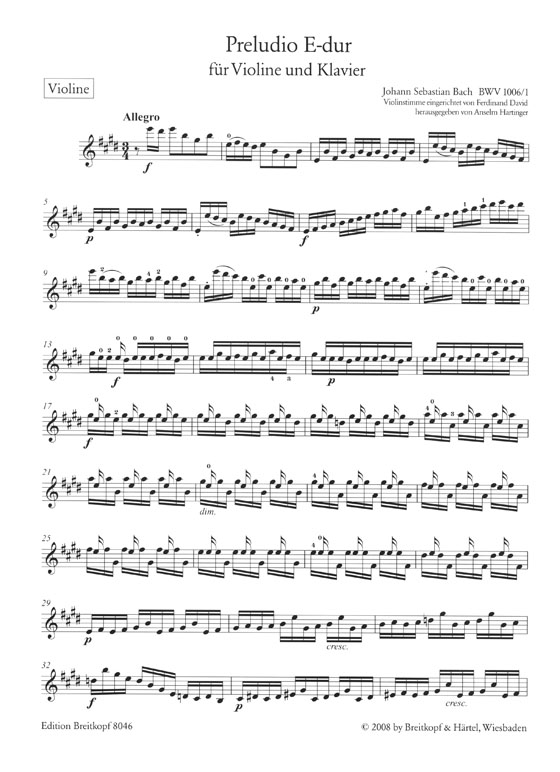




巴哈留下六首小提琴獨奏的奏鳴曲,一般稱為無伴奏奏鳴曲,不只是巴哈小提琴音樂的最高傑作,亦是巴哈全部作品中最傑出的音樂,作品豐麗幻想,情感奔放,技巧高超。此後Felix Mendelssohn Bartholdy孟德爾頌對他的作品進行了發掘、整理和推廣,將此著名無伴奏小提琴奏鳴曲與組曲中的E大調第三組曲,BWV 1006-1前奏曲與d小調第二組曲,BWV 1004-5夏康舞曲配上鋼琴伴奏,小提琴演奏家 Feldinand David 費迪南德·戴維演奏。小提琴分譜原典版、指法注解版+鋼琴伴奏譜。
- 庫存狀況: 缺貨
- 出版社: BREITKOPF & HARTEL
- 作者: Johann Sebastian Bach
- 編訂者: Mendelssohn, Anselm Hartinger
- 出版日期: 1970/1/1
- 總書頁: 53
- 商品編號: EB8046
- ISBN: 9790004182789
簡介
The renaissance of the works of Johann Sebastian Bach in the 19th century is closely connected to the arrangements produced by famous musicians in an effort to make the sometimes strange and forbidding-sounding works palatable to a broad public.
In 1853 Robert Schumann added a piano accompaniment to Bach's cello suites; however, only the music to the Third Suite BWV 1009 has survived (EB 8431). But already on 8 February 1840, Felix Mendelssohn Bartholdy had accompanied Leipzig Gewandhaus concertmaster Ferdinand David at the piano in the performance of the two works for solo violin by Bach, whereby the "Preludio" was played as an encore. The famous "Chaconne for violin and piano" was published a few years later by no less than two publishers! Surprisingly, the former encore piece remained unpublished to this day.
Arrangements and adaptations of all kinds constitute a central component of the rediscovery and cultivation of Bach in the 19th century, the actual scope of which is still underestimated. Around and after 1800, large-scale adaptations and reworkings were often the prerequisite for the revival of Bach’s works in the concert hall. Only in such forms did many of his works reach a broad audience at all, one that went beyond the mere circle of initiates. The best and most famous musicians of their day – Felix Mendelssohn Bartholdy, Robert Schumann, Ferdinand David, Moritz Hauptmann, Ignaz Moscheles and others – all busily adapted, arranged and supplemented Bach’s works.
The addition of piano accompaniments to Bach’s sonatas, partitas and suites for violin and violoncello solo thus does not represent a curiosity of music reception and history; indeed, it stands for the characteristic, successful and musically very sophisticated main artery of Bach renaissance in the romantic era. These reworkings unite the striving for a contemporary sound and formal elaboration of the pieces with performance-practical considerations and a deference towards the preferences and reception habits of the public. After some initial skepticism, this type of performance, which brought Bach’s violin soli more in line with classical sonata movements and romantic concert pieces, was generally very well received by the contemporary public and the musical press. However, these arrangements came under a great deal of fire at the onset of well-founded musicological evaluation in the 20th century. Scholars faulted above all the formal appearance of the pieces, which, as a result of the arrangement, was clearly different and prevailingly un-historical. Behind the criticism of these arrangements was the all too understandable endeavor to free Bach’s original music text from the disfigurations of the late-romantic orchestral culture. However, one should not overlook the fact that at least the early arrangements of the Mendelssohn and Schumann generation strove to provide the respective Bach work with an appropriate and genuinely sparing support, a modern-day commentary that remained stylistically related to the Baroque idiom.
For many decades, concert culture ignored these arrangements, which were unilaterally seen as falsifications and, moreover, were hard to come by. But with the increasing popularity of historical performance practice, especially as it began to spread to works of the romantic era, these arrangements have now also been subjected to a new assessment. Seen from this angle, the versions of Mendelssohn, Schumann and other musicians are being published as aural testimonies of the romantic sound ideal and of Bach reception, and as the result of the collaborative treatment of Bach’s basic musical material by significant composers and virtuosos. Above all, these arrangements are strikingly sounding variants that are able to convey new and sometimes surprising insights into the work even to violinists who are already familiar with the pieces. The charming and – to put it in the language of the romantic era – “deeply combinatory” recital pieces significantly expand the less than abundant repertory of violin literatur in the circle of Mendelssohn and Schumann.
The public concert history of the piano accompaniments supplemented by Mendelssohn begins in the year 1840. The program of the “Third Musical Evening Amusement” of 8 February 1840 featured the Chaconne in D minor as well as the Preludio in E major, the latter in the form of an unannounced encore. They were both heard that evening for the first time at Leipzig’s Gewandhaus. The violinist, the concertmaster Ferdinand David, was supported at the piano by Felix Mendelssohn Bartholdy with an accompaniment that seemed to be improvised, but had been broadly laid down in writing previously. In the following years, both pieces were often performed by Mendelssohn and David, and later by other violinists as well, such as Joseph Joachim. The accompanied and unaccompanied performance tradition apparently existed side by side, both being practically equal in importance. And, as is confirmed by their repeated inclusion among the examination pieces, the violin partitas, along with Mendelssohn’s piano accompaniments, also played a role in the curriculum and musical practice of the Leipzig Conservatory (founded in 1843), where Mendelssohn, David and, temporarily, Joachim all taught.
The transmission and printing history of Mendelssohn’s arrangements is clearly more problematic. As in the case of Mendelssohn’s other Bach editions, the impulse for the publication in 1847 came from an English publisher (Ewer & Co.); the first German edition was published the following year by Breitkopf & Härtel, which maintained close relations to Mendelssohn. Up to now, it had only been possible to find hints and traces of the composer’s participation in the production of the engraver’s masters (Mendelssohn had died in November 1847);however, more recent research has confirmed the existence of a manuscript predating 1847, but which is lost today. An early copy of the accompaniment, which Ferdinand David offered to Joseph Fischhof as a gift and which is most likely identical to the version performed in 1840, is included in this edition as an additional source.
The piano accompaniment to the Preludio, in turn, was printed neither during nor after Mendelssohn’s lifetime. The main source is the autographic transcription by Felix Mendelssohn Bartholdy, which is dated November 1846 and bears a dedication to Ferdinand David; in addition, there is a contemporary copy in the hand of Peter Paul Julius David, the son of Ferdinand David.
Valuable indications pertaining to the dynamics and phrasing of the violin part are found in the edition of the Sonaten und Partiten für Violine solo, which was published by Friedrich Kistner in 1843 in an edition by Ferdinand David.
The present new edition of the Chaconne and the first edition of the accompaniment to the Preludio would not have been possible without the kind support of various individuals and institutions. In particular, the editor wishes to thank Dr. Ralph Kohn (London) for kindly letting him consult the autograph, as well as Dr. Stephen Roe (London), Dr. Peter Wollny (Leipzig), Dr. Ralf Wehner (Leipzig) and Dr. Rudolf Elvers (Berlin) for valuable information. The editor also wishes to thank the library of the Universität der Künste Berlin (in particular Dr. Rothe and Ms. Sidow) as well as the Music Department of the Staatsbibliothek zu Berlin (Dr. Helmut Hell) for putting sources at his disposal and supporting his research.
Leipzig, Spring 2007 Anselm Hartinger
目錄
- Preludio E-dur BWV 1006/1
- Chaconne d-moll BWV 1004/5
詳細規格
| 書籍資訊 | |
| 記譜法 | 五線譜(一般) |
| 原文語言 | 德文 |
| 特徵 | 西洋古典 |
| 樂器 | 小提琴 |
| 古典作曲家 | Bach J.S 巴哈(巴赫) |
| 時期與風格 | 巴洛克樂派 |
| 裝訂 | 平裝 |
| 形式 | 譜 |
| 外型尺寸 | 大於A4 樂譜常用尺寸 |

